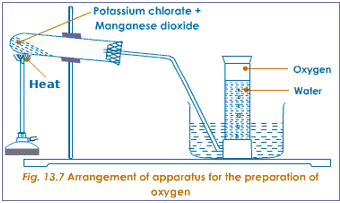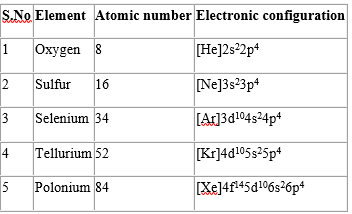Oxygen is the most abundant element on earth. It is found almost in everything in nature and also in free state. Oxygen is a gas under ordinary conditions of temperature and pressure and it is a gas that is colorless, odorless, tasteless and slightly heavier than air, all these physical properties are characteristic of this element.
Laboratory Preparation of Oxygen
Oxygen can be prepared in a number of ways in the laboratory. These include:
(a). Heating a mixture of potassium trioxochlorate(V), KClO3 and maganese(IV) oxide, MnO2.
The MnO2 acts as a catalyst. The reaction is actually the decomposition of KClO3.
2KClO3(s) → 2KCl(s) + 3O2(g)
The laboratory setup for preparation of oxygen is shown below.

(b). The decomposition of hydrogen peroxide, H2O2 using manganese(IV) oxide – this does not require heating.
Hydrogen peroxide is added drop wisely unto MnO2.
2H2O2(aq) → 2H2O(l) + O2(g)
Or by the drop wise addition of hydrogen peroxide on acidified KMnO4
5H2O2(aq) + 2KMnO4(aq) + 3H2SO4(aq) → K2SO4(aq) + 2MnSO4(aq) + 8H2O(l) + 5O2(g)
(c). The reaction between water and sodium peroxide.
Hydrogen peroxide is formed, and it immediately decomposes by the catalytic effect of the OH– ions in solution.
Na2O2(s) + 2H2O → H2O2 + 2Na+ + 2OH–
Then, 2H2O2 → 2H2O + O2
(d). Application of heat on trioxonitrate(V) salts of metals.
Trioxonitrate(V) salts of metals, e.g, sodium trioxonitrate(V), NaNO3 give off a part of their oxygen upon being heated. NaNO3 loses one third of its oxygen.
2NaNO3(s) → 2NaNO2(s) + O2(g)
(e). Application of heat on certain oxides of the least active metals, e.g., mercury oxide, HgO and silver oxide, Ag2O. These oxides undergo complete dissociation when heated.
2HgO(s) → 2Hg(s) + O2(g)
2Ag2O(s) → 4Ag(s) + O2(g)
(f). Application of heat on oxides of certain metals with more than one oxidation state, e.g., lead(IV) oxide, PbO2 and mangan- ese(IV) oxide, MnO2.
These oxides give off only a part of their oxygen when they are heated. Such reactions usually require very high temperatures.
2PbO2(s) → 2PbO(s) + O2(g)
3MnO2(s) → Mn3O4(s) + O2(g)
(g). The electrolysis of water.
Oxygen is produced at the anode.
Test for Oxygen
Oxygen can be distinguished from all other gases except dinitrogen oxide, N2O by its rekindling of a glowing splint of wood.
It is however distinguished from N2O by the following observations:
(1). Oxygen does not have smell, while N2O has a sweet, sickly smell.
(2). Oxygen produces brown fumes of nitrogendioxide, NO2 with nitrogen monoxide,
2NO(g) + O2(g) → 2NO2(g) (brown fumes),
while N2O does not.
Properties of Oxygen
Physical Properties:
It is colourless, has no odour and is neutral.
It is slightly soluble in water.
Density – The density increases down the group with the increase in atomic number.
Melting point and boiling point – It shows a regular increase down the group.
Ionization energy – These elements possess large values on ionization energies which decreases gradually from O to Po. The decrease in ionization energy from oxygen to polonium is due to increase in size of the atoms and increase in screening effect of the electrons belonging to lower shells.
Metallic and non-metallic character – Metallic character depends on ionization energy. Lesser the ionization energy greater will be the metallic character. As we move down the group the ionization energy decreases and therefore the metallic character increases.
Catenation – In this group only S has a strong tendency of catenation. Oxygen also shows this tendency to a limited extent.
Oxidation state – Oxygen being first member in this group shows -2 oxidation state in its compounds owing to its high electronegativity. It also exhibit -1 in H2O2 and zero in O2. Unlike oxygen the other elements have a tendency to show +2, +4 and +6 oxidation states.
Multiple bond formation – The tendency of these elements to form multiple bonds to carbon and nitrogen decreases as we move down the group from sulfur to tellurium.
Electron affinity – These elements have high electron affinity and on moving down the group the size of the atom increases and distance of valence shell from nucleus increases. The additional electron feels lesser attraction as we move down the group and hence electron affinity decreases.
Electronegativity – Oxygen is strongly electronegative in character. The value of electronegativity decreases with increase in atomic number down the group. This is due to increase in size of the atoms and decrease in effective nuclear charge as we move down the group.
Elemental state – Oxygen exist in a diatomic gaseous state at room temperature while other elements are solids.
Allotropy – All elements of the group exhibit allotropy. Oxygen exists in diatomic and triatomic states. Sulfur is found as rhombic, plastic and colloidal sulfur. Selenium has rhombic, mono clinic and grey forms. The grey form is the most stable form and consists of regularly arranged spirals of selenium atoms
It is very active and reacts with many metals and non-metals to form basic and acidic oxides respectively.
Basic oxide – examples include MgO, Na2O and CaO;
Acidic oxide – examples are CO2, SO2 and P4O10 (acidic oxides of non-metal are also called acid anhydrides).
Summary of Reactivity of Oxygen with Metals
K, Na, Ca, Mg, Al, Zn, Fe, Pb, Cu – – show decreasing readiness to form oxides when heated in air, with Cu the least reactive with oxygen.
Hg, Ag, Au – – these metals show the least readiness to form oxides. Their oxides are easily decomposed to the
metal and oxygen.
K, Na, Ca, Mg, Al, Zn – – the oxides of these metals are not reduced to the metals by heating in a stream of hydrogen,
carbon or carbon(II) oxide.
Fe, Pb, Cu – – the oxides of these metals are reduced to the metals by heating in a stream of hydrogen, carbon or carbon(II) oxide.
Note: the more readily a metal combines with oxygen to form an oxide, the less readily it will be reduced to the metal by either heating in a stream of hydrogen or CO.
Therefore, the oxides of K to Zn are not reduced, while those of Fe and below are reduced.
Chemical Properties:
(1). Reaction with compounds – most hydrocarbons and compounds of carbon, hydrogen and oxygen burn in oxygen to form carbon (IV) oxide and water.
CH4(g) + 2O2(g) → CO2(g) + 2H2O(g)
C2H5OH(l) + 3O2(g) → 2CO2(g) + 3H2O(g)
4NH3(g) + 5O2(g) → 4NO(g) + 6H2O(l)
Formation of oxides
The elements of this group form a number of oxides. Some of the oxides formed by these elements are SO, TeO, PoO, SO2, SeO2, TeO2, PoO2, SO3, SeO3 and TeO3. All elements form monoxide. All elements form dioxide with formula MO2. SO2 is a gas, SeO2 is a volatile solid while TeO2 and PoO2 are non-volatile crystalline solids.
Selenium and tellurium dioxides are solids having polymeric chain. The acidic character of the dioxides decreases as we move down the group.
Formation of oxyacids
Theoxyacids of sulfur are more numerous and important than those of Se and Te. The list of oxyacids of sulfur are H2SO4, H2SO3, H2SO5 (Caros acid), H2S2O8 (Marshells acid), H2S2O3, H2S2O6 and H2S2O7. Selenium form selenous acid (H2SeO3) and Selenic acid (H2SeO4) and Tellurium form tellurous acid (H2TeO3) and telluric acid (H2TeO4).
Oxygen Family Elements
Elements listed below belongs to Group 16 (VI A) of the long form of periodic table. Except Po all other elements are also called chalogens, which means ore or mineral forming elements. Out of all these elements oxygen, sulfur and tellurium are non metals while polonium is a radioactive metal.
Atoms of these elements have the outer electronic configuration as ns2np4, where n varies from 2 to 6.

There are two half filled p-orbitals which are used for bonding with other elements. From the similar outer electronic configuration of these elements it is expected that they will show similar physical and chemical properties.
Oxygen Family Facts
- Oxygen is the most abundant element (46.5%) in the earth crust.
- Joseph Priestley obtained oxygen by focusing the sun light on mercuric oxide in 1774.
- About 21% of the components of dry air consist of O2
- In combined state it is also present in plants and animals tissues.
- Ozone is the second form of oxygen and considered as its allotrope.
- It has three isotopes of atomic weight 16, 17 and 18 in the ratio of about 10,000:1:8.
- Oxygen always exist as diatomic (O2) molecule.
- With metallic elements oxygen forms ionic compounds.
- Oxygen reacts with non metals to form a large number of molecular compounds.
- Only the noble gases and few inactive metals such as Pt and Au do not react directly with oxygen.
Oxygen Family Name
- The elements oxygen, sulfur, selenium, tellurium and polonium constitute of group VI A of periodic table.
- In the long form of periodic table they find place in group 16 and p-block elements.
- First four members of this group (O, S, Se, Te) are also known as chalcogens from Greek words “chalkos” for copper and “genes” for “born”. Most copper minerals are either oxygen or sulfur compounds.
- Polonium is a radioactive element and is the most metallic in the group.
Uses of Oxygen
(1). Used as an aid for breathing where problem of breathing arises. Example in high altitude flying or climbing, and when a patient is under anesthetics.
(2). In the oxyacetylene (i.e. oxygen-ethyne) flame – used in welding and cutting steel plate – due to the very high temperature of the flame (about 2200oC).
(3). Used in the L-D process for making steel.
Commercial Production of Oxygen from Liquid Air
The process involves air firstly liquefied by compression, cooling, expansion and successive cooling. Then by fractional distillation of the liquid air – oxygen is separated.
Liquid air contains mainly oxygen and nitrogen. Nitrogen evolves first at 77 K while oxygen evolves later at 90 K, 760 mm Hg.
The laboratory setup for preparation of oxygen is shown below.
Compounds of Oxygen
Oxygen in organic compound can occurs in a variety of forms in nature. The list of oxygen compounds are alcohols, ethers, phosphates, aldehydes, ketones, amide, esters, oxides, carbonyl compounds etc. Oxygen compounds are given in the below table with their general formula.

EVALUATION
1.Describe the properties of oxygen.
2.State all the allotropes of oxygen.
3.Draw a well labeled diagram of the laboratory preparation of oxygen
4.Mention the only allotropes of Oxygen.How is it prepared?
5.What are the uses of oxygen
post your answers on the forum for review
Read our disclaimer.
AD: Take Free online baptism course: Preachi.com 